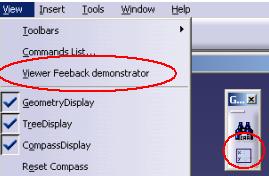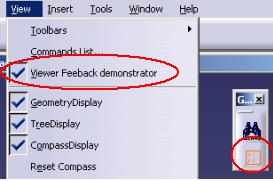
- When the button is "checked", a command header A is started which itself launches a command 1
- When the button is "unchecked", a command header B is started which itself launches a command 2
3D PLM Enterprise Architecture |
User Interface - Frame |
Creating a Check ButtonUsing CATAfrCheckHeaderAccessor |
| Use Case | ||
AbstractThis article shows how to integrate in a workbench a check button in order to launch a command when the button is "checked" and another one when the state of the button becomes "unchecked". |
This use case is intended to show you how integrate in a workbench a button which launches a command when the button is checked and another one when the button is unchecked. It is possible thanks to a command header [1] whose the representation is a check button. This specialized command header is a check header. This picture below explains the internal process:
 |
|
This article explains how to:
A check header can be also used without starting command headers. In this case, only the "checked" or "unchecked" state is interesting. This kind of usage is described in another use case [2] .
[Top]
CAAAfrViewerFeedbackHdr is a use case of the CAAApplicationFrame.edu framework that illustrates Application framework capabilities.
[Top]
The CAAAfrViewerFeedbackHdr use case inserts in the General workshop [3] a check header whose the title is "Viewer Feedback demonstrator". The left picture shows the check header with the state "off", and the right picture with the state "On". In the two cases you have the representation of the header in the menu bar and the tool bar.
 |
 |
When the state is "checked", if there is a current viewer, some information, such as the mouse position, is displayed in the 2D viewpoint as the image shows it below. Refer to the "Viewer Feedback" use case for details about this rendering [4].
 |
[Top]
To launch CAAAfrViewerFeedbackHdr, you will need to set up the build time environment, then compile CAAAfrViewerFeedbackHdr along with its prerequisites, set up the run time environment, and then execute the use case [5].
But just before launching the execution, edit the CAAApplicationFrame.edu.dico interface dictionary file located in the dictionary directory of the CAAApplicationFrame.edu framework:
| Windows | InstallRootDirectory\CAAApplicationFrame.edu\CNext\code\dictionary\ |
| UNIX | InstallRootDirectory/CAAApplicationFrame.edu/CNext/code/dictionary/ |
where InstallRootDirectory is the directory where the CAA CD-ROM
is installed.
In this file, remove the "#" character before the two following lines:
... #CAAAfrGeneralWksAddin CATIWorkbenchAddin libCAAAfrGeneralWksAddin #CAAAfrGeneralWksAddin CATIAfrGeneralWksAddin libCAAAfrGeneralWksAddin ... |
[Top]
The CAAAfrViewerFeedbackHdr use case is made of several classes located :
In the CAAAfrGeneralWksAddin.m module of the CAAApplicationFrame.edu framework
| Windows | InstallRootDirectory\CAAApplicationFrame.edu\CAAAfrGeneralWksAddin.m\ |
| Unix | InstallRootDirectory/CAAApplicationFrame.edu/CAAAfrGeneralWksAddin.m/ |
There is a single class, the CAAAfrGeneralWksAdn class, which is an implementation of the CATIAfrGeneralWksAddin interface [3]. If the "Making Your Document Independent Command Available in All Workbenches" use case explains the implementation of this interface, this article only details the check header instance creation and its integration in menu bar and tool bar.
In the CAACafViewerFeedback.m module of the CAACATIAApplicationFrm.edu framework
| Windows | InstallRootDirectory\CAACafCATIAApplicationFrm.edu\CAACafViewerFeedback.m\ |
| Unix | InstallRootDirectory/CAACafCATIAApplicationFrm.edu/CAACafViewerFeedback.m/ |
There are the CAACafViewerFeedbackCmd and the CAACafViewerFeedbackManager classes. The first is a command which is described in this article. The second is an object to manage the viewer feedback which is only detailed in the Visualization use case [4].
where InstallRootDirectory is the directory where the CAA CD-ROM
is installed.
[Top]
There are four logical steps in the CAAAfrViewerFeedbackHdr use case:
[Top]
The CAAAfrGeneralWksAdn class is an implementation of the CATIAfrGeneralWksAddin interface which is an Add-in of the General workshop [3]. Like other Add-in implementations, there are two methods to consider:
CreateCommands, the method to create
the command header instances,CreateToolbars, the method to
arrange the command header instances in menu bar and tool bar. Since this
piece code is not in relationship with the topic of this article, refer to the
CAAAfrGeneralWksAddin use case [3] for details.Extract of the CreateCommands method
...
void CAAAfrGeneralWksAdn::CreateCommands()
{
...
CATAfrCheckHeaderAccessor ViewerFeedbackHdrAccessor ("CAAAfrViewerFeedbackHdr");
ViewerFeedbackHdrAccessor.SetResourceFile("CAAAfrGeneralWksAddinHeader");
...
}
|
The CATAfrCheckHeaderAccessor class enables you to create an instance
of a non-exposed check header class. "CAAAfrViewerFeedbackHdr"
will be the check header internal name. The SetResourceFile method
allows you to specify in which filename, the Nls and Rsc resources will be set.
See the Creating the Check Header Resources
section.
Then, the behavior for the "check" and "uncheck" states are specified.
... CATCommandHeader * pHdr = (CATCommandHeader*) new
CAAAfrGeneralWksAddinHeader("CAACafViewerFeedbackCheckHdr",
"CAACafViewerFeedback",
"CAACafViewerFeedbackCmd", (void *)1);
pHdr->SetVisibility(0);
pHdr = (CATCommandHeader*) new
CAAAfrGeneralWksAddinHeader("CAACafViewerFeedbackUncheckHdr",
"CAACafViewerFeedback",
"CAACafViewerFeedbackCmd", (void *)2);
pHdr->SetVisibility(0);
ViewerFeedbackHdrAccessor.SetCheckCommand("CAACafViewerFeedbackCheckHdr");
ViewerFeedbackHdrAccessor.SetUncheckCommand("CAACafViewerFeedbackUncheckHdr");
|
The CAAAfrGeneralWksAddinHeader class has been automatically
created with the MacDeclareHeader macro insert in the CAAAfrGeneralWksAdn.cpp
file [3]. The arguments of the two
instances are:
CAACafViewerFeedbackCheckHdr/CAACafViewerFeedbackUncheckHdr: the internal name of the
two command header instances. CAACafViewerFeedback: name of the library exporting the CAACafViewerFeedbackCmd
commandCAACafViewerFeedbackCmd: name of the command which
set/unset the viewer feedback. This class is explained further, see the Creating the Check/Uncheck Command
section.1/2: arguments of the CAACafViewerFeedbackCmd
commandThe SetVisibility method of the CATCommandHeader class
prohibits that the two instances, CAACafViewerFeedbackCheckHdr and CAACafViewerFeedbackUncheckHdr
appear in the Customize command. The end user which do not known the identifier
of command header cannot launch them in the power input, or drag and drop the
command in a toolbar. See the technical article for more information about this
method [1].
Associating the CAACafViewerFeedbackCheckHdr header instance
with the "Check" state, thanks to the SetCheckCommand
method, the CAACafViewerFeedbackCmd with 1 as argument will be
finally launched when the end use will check the check button.
Associating the CAACafViewerFeedbackUncheckHdr header
instance with the "Uncheck" state, thanks to the SetUncheckCommand
method, the CAACafViewerFeedbackCmd with 2 as argument will be
finally launched when the end use will uncheck the check button.
[Top]
The aim of this section is to explain the command which is launched when the end user selects the "Viewer Feedback Demonstrator" check button. This command is a CAACafViewerFeedbackCmd class:
CAACafViewerFeedbackCmd header file
#include "CATCommand.h"
class CAACafViewerFeedbackCmd : public CATCommand
{
public :
CAACafViewerFeedbackCmd(void * iArgument);
virtual ~CAACafViewerFeedbackCmd();
private :
CAACafViewerFeedbackCmd ();
CAACafViewerFeedbackCmd(const CAACafViewerFeedbackCmd &iObjectToCopy);
CAACafViewerFeedbackCmd & operator = (const CAACafViewerFeedbackCmd &iObjectToCopy);
};
|
The CAACafViewerFeedbackCmd class is a CATCommand class without methods. The default constructor, the copy constructor, and the assignment operator are set as private, and are not implemented in the source file. This prevents the compiler from creating them as public without you know.
CAACafViewerFeedbackCmd source file
...
#include "CATCreateExternalObject.h"
CATCreateClassArg(CAACafViewerFeedbackCmd,void *);
CAACafViewerFeedbackCmd::CAACafViewerFeedbackCmd(void *iArgument):
CATCommand(NULL,"CAACafViewerFeedbackCmdId")
{
CAACafViewerFeedbackManager * pCAACafViewerFeedbackManager = NULL ;
CAACafViewerFeedbackManager::GetManager(&pCAACafViewerFeedbackManager);
if ( NULL != pCAACafViewerFeedbackManager )
{
int state = (int) iArgument ;
if ( 1 == state )
{
pCAACafViewerFeedbackManager->SetViewerFeedbackOn();
}else
{
pCAACafViewerFeedbackManager->SetViewerFeedbackOff();
}
...
}
RequestDelayedDestruction();
}
|
The CATCreateClassArg macro enables any command
header (a CATCommandHeader class) to instantiate a CATCommand by
its name and with an argument.
The first argument, NULL, given to the CATCommand class
means that the parent of the command is the current command selector [6]. The second argument ("CAACafViewerFeedbackCmdId") is
the internal name of the command. This CATCommand is undefined [6]
(the default behavior of a CATCommand) because this command should not
disturb the current active command.
What it is necessary to retain in this class is the command's life cycle. The
CAACafViewerFeedbackCmd is instantiated by a command header but not
deleted by this command header, therefore the CAACafViewerFeedbackCmd
should manage its deletion. But as the CATCommand is undefined [6],
it means that it is not seen by the focus manager and cannot be activated,
deactivated or canceled as usual for commands launched from a command header. So
a RequestDelayedDestruction instruction is done at the end of the
constructor. The three mandatory rules to respect for such call in a command's
constructor are :
RequestDelayedDestruction is the last instruction.For details about the CAACafViewerFeedbackManager refer you to the Visualization use case [4].
[Top]
A method of the CAACafViewerFeedbackManager class needs to know the state of the check header.
...
void CAACafViewerFeedbackManager::WindowActivatedCB( CATCallbackEvent event,
void * client,
CATNotification * notification,
CATSubscriberData data,
CATCallback callback)
{
CATAfrCheckHeaderAccessor ViewerFeedbackHdrAcc("CAAAfrViewerFeedbackHdr") ;
if( 1 == ViewerFeedbackHdrAcc.IsChecked() )
{
...
}
}
...
|
The WindowActivatedCB is a callback method called when a window of the frame is activated. Before launching an action, you want to know
the state of the check header in the window's context, in other words the state
of the check header which has been created when the document displaying in the
window has been opened. The CATAfrCheckHeaderAccessor class constructor
tests that the check header already exists in the list of command for the
current editor, before to create it. In all cases, after the CATAfrCheckHeaderAccessor
constructor class, you have an access to the check header contained in the list
of command headers dedicated to the current editor. Refer you to the "Life
Cycle management" section of the technical article about command headers [1]
to understand the relationship between editor (CATFrmEditor class)
and command header (CATCommandHeader class).
[Top]
Previously in the "Creating the Check Header Instance in Add-in"
section, just after the check header creation through the CATAfrCheckHeaderAccessor
class, the resource file name has been specified thanks to the SetResourceFile
method. In this use case the prefix of the file name is "CAAAfrGeneralWksAddinHeader".
You retrieve the CAAAfrGeneralWksAddinHeader.CATNls and CAAAfrGeneralWksAddinHeader.CATRsc
files in the CNext/resources/msgcatalog directory of the CAAApplicationFrame.edu
framework.
The CAAAfrGeneralWksAddinHeader.CATNls file contains:
... CAAAfrGeneralWksAddinHeader.CAAAfrViewerFeedbackHdr.Category = "View" ; CAAAfrGeneralWksAddinHeader.CAAAfrViewerFeedbackHdr.Title = "Viewer Feeback demonstrator" ; CAAAfrGeneralWksAddinHeader.CAAAfrViewerFeedbackHdr.ShortHelp = "Viewer Feeback demonstrator" ; CAAAfrGeneralWksAddinHeader.CAAAfrViewerFeedbackHdr.Help = "Demonstrator of the Viewer CAA API" ; CAAAfrGeneralWksAddinHeader.CAAAfrViewerFeedbackHdr.LongHelp = "Viewer Feeback demonstrator This command checks or uncheks the feedback of the cursor in the current viewer." ; ... |
and the CAAAfrGeneralWksAddinHeader.CATNls file contains:
... CAAAfrGeneralWksAddinHeader.CAAAfrViewerFeedbackHdr.Icon.Normal = "I_CAAViewerFeedback" ; ... |
where :
CAAAfrGeneralWksAddinHeader: is the file nameCAAAfrViewerFeedbackHdr: is the command header
identifier. Category, Title, ShortHelp, Help, Icon.Normal and
LongHelp : keywords for a command header [7][Top]
This article explains how to use the CATAfrCheckHeaderAccessor class to create or retrieve a check header.
[Top]
| Version: 1 [Aug 2003] | Document created |
| [Top] | |
Copyright © 2003, Dassault Systèmes. All rights reserved.